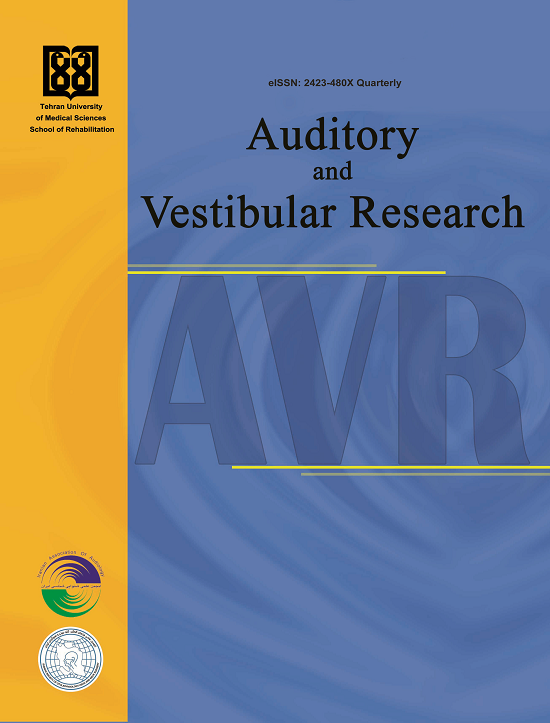Real-ear Unaided Gain in Wrestlers with Unilateral Cauliflower Ear
Abstract
Background and Aim: Real-Ear Unaided Gain (REUG) can reveal the outer-ear resonance which reflects the effects of body and ear factors. Deformity in the outer ear may change the real-ear unaided responses. Cauliflower ear is a common ear deformity in wrestlers. This study aimed to compare the REUG of normal and cauliflower ear in wrestlers to investigate the frequencies at which the gain may be inaccurate.
Methods: Ten male wrestlers with the age ranged from 21 to 31 years participated in this study. The study had within-subject design and only one group. The REUGs was recorded for both ears, normal and cauliflower ears, and the results analyzed.
Results: The mean of REUG values were significantly different between the deformed and normal ears. There were two distinct peaks in the REUG curve of the deformed ear, while there was a single peak in that of the normal ear.
Conclusion: The differences in the REUG at 2–6 kHz between the deformed and normal ears was seen.
[2] Kordi R, Mansournia MA, Nourian RA, Wallace WA. Cauliflower Ear and Skin Infections among Wrestlers in Tehran. J Sports Sci Med. 2007;6(CSSI-2):39-44.
[3] Schuller DE, Dankle SK, Martin M, Strauss RH. Auricular injury and the use of headgear in wrestlers. Arch Otolaryngol Head Neck Surg. 1989;115(6):714-7. [DOI:10.1001/archotol.1989.01860300068019]
[4] Ohlsén L, Skoog T, Sohn SA. The pathogenesis of cauliflower ear. An experimental study in rabbits. Scand J Plast Reconstr Surg. 1975;9(1):34-9. [DOI:10.3109/02844317509022854]
[5] Giffin CS. Wrestler’s ear: pathophysiology and treatment. Ann Plast Surg. 1992;28(2):131-9. [DOI:10.1097/00000637-199202000-00002]
[6] Skoog T, Ohlsén L, Sohn SA. Perichondrial potential for cartilagenous regeneration. Scand J Plast Reconstr Surg. 1972;6(2):123-5. [DOI:10.3109/02844317209036711]
[7] Pandya NJ. Experimental production of “cauliflower ear” in rabbits. Plast Reconstr Surg. 1973;52(5):534-7. [DOI:10.1097/00006534-197311000-00010]
[8] Roy S, Smith LP. A novel technique for treating auricular hematomas in mixed martial artists (ultimate fighters). Am J Otolaryngol. 2010;31(1):21-4. [DOI:10.1016/j.amjoto.2008.09.005]
[9] Noormohammadpour P, Rostami M, Nourian R, Mansournia MA, Sarough Farahani S, Farahbakhsh F, et al. Association Between Hearing Loss And Cauliflower Ear in Wrestlers, a Case Control Study Employing Hearing Tests. Asian J Sports Med. 2015;6(2):e25786. [DOI:10.5812/asjsm.6(2)2015.25786]
[10] Ballachanda BB. Theoretical and applied external ear acoustics. J Am Acad Audiol. 1997;8(6):411-20.
[11] Ricketts TA, Bentler R, Mueller HG. Essentials of Modern Hearing Aids: Selection, Fitting, and Verification. 1st ed. San Diego: Plural Publishing, Inc.; 2017.
[12] Shaw EA. Transformation of sound pressure level from the free field to the eardrum in the horizontal plane. J Acoust Soc Am. 1974;56(6):1848-61 [DOI:10.1121/1.1903522]
| Files | ||
| Issue | Vol 32 No 3 (2023) | |
| Section | Short Article(s) | |
| DOI | https://doi.org/10.18502/avr.v32i3.12942 | |
| Keywords | ||
| Cauliflower ear real ear unaided gain probe microphone measurement ear canal resonance | ||
| Rights and permissions | |

|
This work is licensed under a Creative Commons Attribution-NonCommercial 4.0 International License. |






